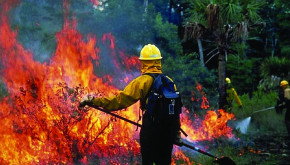
Depending on where you live in the United States, wildfires can be frequent natural disasters or rare events. What are wildfires? Knowing wildfire basics can help you identify and address potential risks around your home and property. All fires need three components: fuel, heat and oxygen. These three compose what is called the fire triangle. In forests, live and dead vegetation, including dry leaves, twigs, logs and grasses, are fuel. Heat sources such as sparks, campfires, trash burn barrels, or lightning strikes start fires. Oxygen is readily available and wind increases the flow of oxygen, dries fuels, and helps increase fire spread and intensity. Remove one side of the triangle and fire cannot occur.
Fire goes through several stages as it spreads. First, heat from the fire dries nearby fuels. Next, the nearby fuels release volatile gases. These volatile gases and nearby fuels ignite. Finally, as the fire intensifies, it rapidly preheats and dries surrounding materials, allowing them to ignite and carry the fire through the forest. This process of heat transfer only happens when there is continuity. The fire continues this cycle with nearby fuels. Under certain conditions – for example, dry fuels and high winds – these steps are almost instantaneous. Importantly, as fuel moisture levels increase, more heat is required to evaporate moisture and ignite fuel. This is why most northeastern wildfires tend to be small, burning on average of one acre per fire. However, areas of the Northeast and Midwest can still experience large wildfires, which burn hundreds to several thousand acres when conditions are right.
The fuel, topography, and current weather conditions, including wind speed, determine the direction and rate of fire spread. Fuel, topography, and weather compose the fire behavior triangle. Topography is the slope of the land and the direction the slope faces. Fire moves up steep slopes more quickly as the flames preheat uphill fuels. South- and west-facing slopes are generally hotter and drier. While we can’t alter topography or weather, reducing or eliminating fuels lowers wildfire risk.

